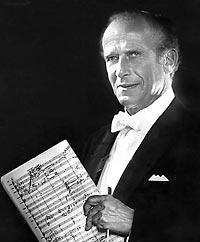Longtime music director shaped Seattle Symphony

For 22 years, Milton Katims was "Mr. Music" to Seattle — a Seattle Symphony maestro so beloved that his photograph once adorned the cover of the Seattle telephone directory.
Mr. Katims, an internationally renowned conductor and violist, died Monday morning in Seattle of heart failure, after a long and fruitful life in music. He was 96.
He was active to the end of his life, attending concerts and playing tennis until a few months ago. His sense of humor was active, too: A few years back, he quipped of his advanced age, "I don't even buy green bananas."
The last surviving protégé of the legendary maestro Arturo Toscanini, Mr. Katims shaped the Seattle Symphony from a struggling part-time orchestra in the mid-1950s into a respected regional symphony that performed regularly with top soloists Mr. Katims had known in New York (such as the late violin legend Isaac Stern). He had a good eye for emerging talent, signing up promising youngsters like Yo-Yo Ma and Itzhak Perlman as soloists long before their names were famous.
"Our orchestra could not be where it is today were it not for Milton's tremendous accomplishments during his 22-year tenure as music director," said Gerard Schwarz, the Seattle Symphony's music director. Mr. Katims taught Schwarz's father-in-law, violist Sol Greitzer, at the Juilliard School.
"His musical gifts were extraordinary as an educator, orchestra musician, chamber musician, soloist and conductor. Milton transformed the Seattle Symphony during his tenure as our music director and was instrumental in the growth of our city into an important cultural center."
Born in New York City to Russian-Hungarian parents (the family name originally was Katimsky), Mr. Katims showed early musical promise on the violin and viola. The viola brought him to prominent notice in the worlds of symphonic and chamber music, and he performed frequently with such renowned ensembles as the Budapest String Quartet. Later, he also became well known as an editor of music for the viola.
As principal violist of the late, great NBC Symphony, Mr. Katims continued a close association with Toscanini, who admired his playing and coached the budding conductor.
In 1947 Mr. Katims became the assistant conductor for the NBC Symphony, and Toscanini invited him to guest conduct that famed orchestra in 52 coast-to-coast broadcasts. That year, Mr. Katims also began teaching at the Juilliard School of Music, a position he held until 1954. Meanwhile, he developed a conducting career that extended from major orchestras in America to those of Israel, Japan and other countries.
When Mr. Katims and his cellist wife, Virginia, arrived in Seattle in 1954 with their two young children, the Seattle Symphony was operating on a budget of less than $200,000 and presenting only eight subscription concerts and a handful of other concerts annually. During the Katims years, the subscribers more than quadrupled, and Mr. Katims added many innovations: a chamber orchestra, young-artists concerts, family concerts, an education program, regional touring, creative programming, and recordings.
During this time, one of America's most influential music critics, the now-deceased Harold Schonberg of The New York Times, wrote: "Mr. Katims had been brought to the orchestra and did great things, turning a provincial group into a real symphony orchestra." He helped to discover young artists, including cellist Yo-Yo Ma, pianist Horacio Gutierrez, harpist Heidi Lehwalder and violinists Kyung-Wha Chung, Cho-Liang Lin and Mark Kaplan.
Even the most popular conductor, however, is not immune to shifts in public opinion, and gradually a contingent in the symphony board grew to believe that Mr. Katims had occupied the podium long enough.
In the mid-1970s, a major Seattle Symphony upheaval split orchestra players and supporters alike into bitter factions, divided by the question of whether to remove Mr. Katims. The anti-Katims faction won; Mr. Katims was ousted as music director and moved to Houston to become artistic director of the University of Houston School of Music.
"I was under the mistaken impression," Mr. Katims said later, "that just being a damned good conductor and having the background that I had was enough, without engaging in politics, too. I was wrong."
Still, the couple made the best of things. Three days after their move to Houston, Virginia gave a party for 50 of Milton's new colleagues, and the couple began the task of working in a completely different environment from low-key Seattle, amid a crowd of flamboyant Texans.
Mr. Katims spearheaded a joint project between the University of Houston and the Houston Grand Opera, creating the Houston Opera Studio. He brought in important guest artists and organized an international piano festival during his eight years in Houston.
Upon his retirement, the lure of grandchildren and the Katimses' many Seattle friends brought the couple back to this city. For a time, he served on the faculty of the University of Washington when a violist was needed. He finally gave up the viola at 91.
Milton and Virginia Katims were inseparable partners in all endeavors, musical and otherwise. Until just recently, the Katimses were fixtures on the Seattle concert scene, always turning up at the concert halls to hear new talent and old favorites. And when he was 95, Mr. Katims and his wife produced a book of musical reminiscence and personal reflections called "The Pleasure Was Ours" (published by Vision Books International).
Throughout his life, Mr. Katims loved playing tennis. On his 95th birthday, he joked that occasionally the opposing players "manage to hit my racquet."
His love of music motivated everything Mr. Katims did. In one interview, he confessed that he would have happily conducted and taught unpaid, for the sheer joy of music. Associating with great musicians, and coaxing great music out of orchestras, gave him a lifetime of pleasure.
As he put it in the final sentence of his book: "Who could be more fortunate than we have been?"
Mr. Katims is survived by his wife of 70 years, Virginia Peterson Katims; their two children, Peter Katims of Byron Bay, Australia, and Pamela Katims Steele of Seattle (husband Patrick and children Michelle and Bryan, all of Seattle); and brother Seymour of Honolulu.
In lieu of flowers, donations can be made in Mr. Katims' name to the Seattle Symphony, Benaroya Hall, 200 University St., Seattle, WA 98101; and to the Milton Katims Viola Scholarship at the University of Washington School of Music, Box 353450, Seattle, WA 98195-3450.
A memorial service will take place 2 p.m. March 12 in Meany Hall on the University of Washington campus. Doors will open at 1:30 p.m.
Melinda Bargreen: mbargreen@seattletimes.com
